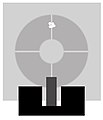Aiming error (weapon)
In shooting and weapons theory, the term target error has a different meaning than in astrometry and geodesy . It describes small angular errors by which the target axis of the weapon aligned by the shooter deviates from the image of the target to be measured with a fired weapon. These aiming errors of a subjective nature relate to shooting with open sights , i.e. via the rear sight and front sight or a closed sight, i.e. diopter . Due to their design, aiming errors in the riflescope are more likely to be referred to as parallax errors.
Causes of Target Failure
Possible causes are inadequate training, clumsiness or optical illusions, caused by unfavorable incidence of light. Bare visor parts, from which the browning or color has been worn away, can intensify this effect through light reflection. Eye defects are also conceivable causes.
Differentiation of target errors
A distinction is made between the following target errors:
- Fine grain
- With fine grain, the top edge of the front sight is lower than the top edge of the rear sight.
- The shots are too deep in this case.
- full grain
- With whole grain, the top edge of the front sight is higher than the top edge of the rear sight.
- The shots are too high in this case.
- Pinched grain
- In this case, the front sight is not exactly in the middle of the rear sight, but shifted to the right (clamped right) or left (clamped left) edge of the rear sight.
- The result is a shot that goes too far to the right when the front sight is clamped on the right and a shot that goes too far to the left with the front sight clamped to the left.
- Canted visor or canted weapon
- When tilting, the entire weapon is held at an angle. In this case, the front sight is not vertical, but also slightly tilted because it is firmly mounted vertically on the weapon. If the sight / weapon tilts to the right, one speaks of tilted right , tilts the weapon to the left, tilted from the left .
- The result is a shot that is too short or too deep in the direction of the respective cant.
Note
The above variants describe a variant with the corresponding hit position as a consequence, based on the sporty sights with "letting the target circle sit up". In practice it can happen that several sighting errors occur at the same time. Whilst fine and whole grains are mutually exclusive, tilting and / or a jammed grain can also be a source of errors. For military sight settings (so-called coated front sight) the possible aiming errors are identical in cause and effect, but the sight images are different.
literature
- Heinz Dathan, weapons apprenticeship for the Bundeswehr. Herford, Bonn (4th edition), ISBN 3-87599-040-4
- Central Service Regulation (ZDv) 3/12 Shooting with handguns






